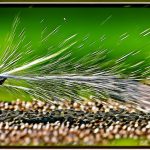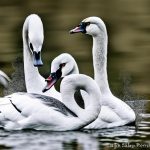Barnacle geese are a species of waterfowl that are native to the Arctic regions of Europe and North America. They are medium-sized birds, with a black head and neck, white face and underparts, and a gray-brown back. Barnacle geese are known for their distinctive call, which sounds like a honking noise.
Fun facts about barnacle geese include their unique breeding habits. Unlike most birds, barnacle geese do not build nests. Instead, they lay their eggs in small depressions on the ground, often near water. Another interesting fact is that barnacle geese are known for their long-distance migrations. They travel thousands of miles each year between their breeding grounds in the Arctic and their wintering grounds in more temperate regions.
Key Takeaways
- Barnacle Geese are migratory birds that breed in the Arctic and winter in Western Europe.
- They prefer coastal habitats with access to both water and grassy areas for feeding.
- Barnacle Geese primarily feed on grasses, sedges, and other vegetation, but will also eat insects and mollusks.
- Their behavior changes seasonally, with breeding and molting periods affecting their movements and social interactions.
- Providing adequate shelter, such as nesting boxes and predator-proof fencing, is important for the health and safety of Barnacle Geese.
Understanding the Barnacle Geese Habitat
Barnacle geese are primarily found in coastal areas, such as salt marshes, estuaries, and coastal grasslands. They prefer habitats that provide both open water for feeding and nesting sites that are safe from predators. In the Arctic, they nest on cliffs or rocky outcrops near the coast.
Barnacle geese have also adapted to different environments. In addition to their Arctic breeding grounds, they can be found in other parts of Europe and North America during the winter months. They are able to survive in a variety of habitats, including agricultural fields, wetlands, and urban areas.
Feeding Habits of Barnacle Geese
Barnacle geese are herbivores and primarily feed on grasses, sedges, and other vegetation. They graze on land and in shallow water, using their bill to pull up plants from the ground or pluck them from the surface of the water. They also feed on agricultural crops such as wheat and barley.
To obtain their food, barnacle geese use a variety of feeding strategies. They may forage individually or in small groups, and they are able to feed both during the day and at night. During the breeding season, they may also feed on insects and other small invertebrates.
Seasonal Changes in Barnacle Geese Behavior
Barnacle geese exhibit different behaviors during different seasons. In the summer months, they are focused on breeding and raising their young. They form large colonies on their breeding grounds and engage in courtship displays to attract mates.
During the winter months, barnacle geese migrate to more temperate regions in search of food. They form large flocks and can often be seen in agricultural fields, where they feed on crops. They may also gather in wetlands or coastal areas, where they can find a variety of plant material to eat.
Migration patterns of barnacle geese are well-studied. They typically follow a north-south migration route, with some populations traveling from the Arctic to northern Europe, and others traveling from the Arctic to North America. The timing of their migration is influenced by factors such as food availability and weather conditions.
Importance of Providing Adequate Shelter for Barnacle Geese
Shelter is important for barnacle geese because it provides protection from predators and harsh weather conditions. Barnacle geese are vulnerable to predation by animals such as foxes, wolves, and birds of prey. Having access to suitable shelter can help them avoid being attacked by predators.
Types of shelter that are suitable for barnacle geese include tall grasses, shrubs, and trees. These provide cover from predators and also offer protection from wind, rain, and extreme temperatures. In urban areas, barnacle geese may seek shelter under bridges or in other man-made structures.
Health Concerns for Barnacle Geese and How to Prevent Them

Like any animal, barnacle geese can experience health issues. Common health problems that affect barnacle geese include infections, parasites, and injuries. They may also be susceptible to diseases such as avian influenza.
To prevent health problems in barnacle geese, it is important to provide them with a clean and safe environment. This includes regular cleaning of their living area, providing access to fresh water for drinking and bathing, and ensuring that they have a balanced diet. Regular veterinary check-ups can also help to identify and treat any health issues before they become more serious.
Tips for Keeping Barnacle Geese Safe from Predators
Barnacle geese have several natural predators, including foxes, wolves, birds of prey, and even other waterfowl. To protect barnacle geese from predators, it is important to create a secure environment for them.
One way to do this is by providing adequate shelter, as mentioned earlier. Tall grasses, shrubs, and trees can provide cover from predators. Fencing can also be used to keep predators out of their living area.
Another way to protect barnacle geese from predators is by using scare tactics. This can include using noise-making devices or visual deterrents such as scarecrows or reflective tape. These methods can help to deter predators from approaching the geese.
Breeding and Reproduction of Barnacle Geese
Barnacle geese typically reach sexual maturity at around two years of age. They form monogamous pairs and mate for life. During the breeding season, they engage in courtship displays, which involve vocalizations and various physical movements.
After mating, the female barnacle goose will lay a clutch of eggs in a small depression on the ground. The eggs are incubated by both parents for about 25-30 days. Once the eggs hatch, the parents will care for the young goslings until they are able to fly, which usually takes about 40-50 days.
Training and Taming Barnacle Geese
Training barnacle geese can be a rewarding experience, but it requires patience and consistency. The key to training barnacle geese is to establish a bond of trust with them. This can be done through positive reinforcement, such as offering treats or praise when they exhibit desired behaviors.
To train barnacle geese, it is important to start with basic commands, such as “come” or “stay.” These commands can be reinforced with treats or other rewards. It is also important to be consistent in your training and to use positive reinforcement consistently.
Taming barnacle geese involves gaining their trust and building a bond with them. This can be done by spending time with them, talking to them in a calm and soothing voice, and offering them treats. Over time, they will become more comfortable with human interaction and may even seek out attention from their caretakers.
Maintaining a Healthy Environment for Barnacle Geese
In conclusion, barnacle geese are fascinating birds that have adapted to a variety of habitats and exhibit unique behaviors. Providing them with a healthy environment that includes adequate shelter, proper nutrition, and protection from predators is essential for their well-being.
By understanding the natural habitat of barnacle geese and their specific needs, we can ensure that they thrive in captivity. Whether they are kept in a zoo or as pets, it is important to provide them with the necessary resources to live a happy and healthy life.
By following the tips outlined in this article, we can create an environment that promotes the physical and mental well-being of barnacle geese. With proper care and attention, these beautiful birds can continue to captivate us with their unique behaviors and adaptability.
If you’re interested in learning more about keeping barnacle geese, you might also find this article on poultrywizard.com helpful. It provides valuable information on the incubation period for goose eggs, which is crucial for successful breeding. Understanding the incubation process is essential for ensuring the health and well-being of your geese. Check out the article here: https://poultrywizard.com/breeding-geese/what-is-the-incubation-period-for-goose-eggs/.
FAQs
What are barnacle geese?
Barnacle geese are medium-sized birds that breed in the Arctic regions of Europe and Asia. They are migratory birds that spend their winters in coastal areas of western Europe.
Why is it important to keep barnacle geese?
Barnacle geese are an important part of the ecosystem and play a role in maintaining the balance of the food chain. They also have cultural and economic significance in some regions.
What are the threats to barnacle geese?
The main threats to barnacle geese include habitat loss, hunting, and climate change. Human activities such as agriculture and urbanization have led to the destruction of their breeding grounds, while hunting has reduced their population in some areas.
How can we keep barnacle geese?
To keep barnacle geese, we need to protect their breeding grounds and wintering areas. This can be done through conservation efforts such as habitat restoration, hunting regulations, and climate change mitigation.
What are some conservation efforts for barnacle geese?
Conservation efforts for barnacle geese include the establishment of protected areas, habitat restoration, hunting regulations, and public education. These efforts aim to reduce the threats to barnacle geese and ensure their long-term survival.
Meet Walter, the feathered-friend fanatic of Florida! Nestled in the sunshine state, Walter struts through life with his feathered companions, clucking his way to happiness. With a coop that’s fancier than a five-star hotel, he’s the Don Juan of the chicken world. When he’s not teaching his hens to do the cha-cha, you’ll find him in a heated debate with his prized rooster, Sir Clucks-a-Lot. Walter’s poultry passion is no yolk; he’s the sunny-side-up guy you never knew you needed in your flock of friends!







